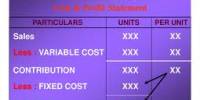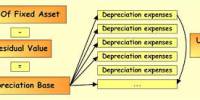Goodwill is a collection of intangible assets that generate earning power superior to that which would be generated by a business’ tangible and separately identifiable intangible assets (e.g., patents, trade names, customer lists, etc.). Intangible assets contribute to, and are thus attributed to, goodwill if by their very nature they cannot (or cannot without great difficulty), be separately identified for purposes of quantification.
There are three methods of valuation of goodwill of the firm;
1. Average Profits Method
2. Super Profits Method
3. Capitalisation Method
1. Average Profits Method:
Under this metod goodwill is calculated on the basis of the average of some agreed number of past years. The average is then multiplied by the agreed number of years. This is the simplest and the most commonly used method of the valuation of goodwill.
Goodwill = Average Profits X Number of years of Puchase
Before calculating the average profits the following adjustments should be made in the profits of the firm:
a. Any abnormal profits shoulld be deducted from the net profits of that year.
b. Any abnormal loss should be added back to the nat profits of that year.
c. Non operating incomes eg. income from investments etc should be deducted from the net profits of that year.
Now we will explain this method with the help of a simple example.
A Ltd agreed to buy the business of B Ltd. For that purpose Goodwill is to be valued at three years purchase of Average Profits of last five years. The profits of B Ltd. for the last five years are:
| Year | Profit/Loss ($) |
| 2005 | 10,000,000 |
| 2006 | 12,250,000 |
| 2007 | 7,450,000 |
| 2008 | 2,450,000 (Loss) |
| 2009 | 12,400,000 |
Following additional information is available:
1. In the year 2008 the company suffered a loss of $1,000,500 due to fire in the factory.
2. In the year 2009 the company earned an income from investments outside the business $ 4,500,250.
Solution:
Total profits earned in the past five years= 10,000,000 + 12,250,000 + 7,450,000 – 2,450,000 + 12,400,000 = $ 39,650,000
Total Profits after adjustments = $ 39,650,000 + $ 1,000,500 – $ 4,500,250=$ 36,150,250
Average Profits= $ 36,150,250÷5=$ 7,230,050
Goodwill = $ 7,230,050×3=$ 21,690,150
Thus A Ltd would pay $ 21,690,150 as the price of Goodwill earned by B Ltd.
2. Super profits method:
Super Profits are the profits earned above the normal profits. Under this method Goodwill is calculated on the basis of Super Profits i.e. the excess of actual profits over the average profits. For examplle if the normal rate of return in a particular type of business is 20% and your investment in the business is $1,000,000 then your normal profits should be $ 200,000. But if you earned a net profit of $ 230,000 then this excess of profits earned over the normal profits i.e. $ 230,000 – $ 200,000= Rs.30,000 are your super profits. For calculating Goodwill, Super Profits are multiplied by the agreed number of years of purchase.
Steps for calculating Goodwill under this method are given below:
i) Normal Profits = Capital Invested X Normal rate of return/100
ii) Super Profits = Actual Profits – Normal Profits
iii) Goodwill = Super Profits x No. of years purchased
For example, the capital employed as shown by the books of ABC Ltd is $ 50,000,000. And the normal rate of return is 10 %. Goodwill is to be calculated on the basis of 3 years puchase of super profits of the last four years. Profits for the last four years are:
| Year | Profit/Loss ($) |
| 2005 | 10,000,000 |
| 2006 | 12,250,000 |
| 2007 | 7,450,000 |
| 2008 | 5,400,000 |
Total profits for the last four years = 10,000,000 + 12,250,000 + 7,450,000 + 5,400,000 = $35,100,000
Average Profits = 35,100,000 / 4 = $ 8,775,000
Normal Profits = 50,000,000 X 10/100 = $ 5,000,000
Super Profits = Average/ Actual Profits − Normal Profits = 8,775,000 − 5,000,000 = $ 3,775,000
Goodwill = 3,775,000 × 3 = $ 11,325,000
3. Capitalisation Method:
There are two ways of calculating Goodwill under this method:
(i) Capitalisation of Average Profits Method
(ii) Capitalisation of Super Profits Method
(i) Capitalisation of Average Profits Method:
Under this method we calculate the average profits and then assess the capital needed for earning such average profits on the basis of normal rate of return. Such capital is called capitalised value of average profits. The formula is:-
Capitalised Value of Average Profits = Average Profits X (100 / Normal Rate of Return)
Capital Employed = Assets – Liabilities
Goodwill = Capitalised Value of Average Profits – Capital Employed
For example a firm earns $40,000 as its average profits. The normal rate of rteturn is 10%. Total assets of the firm are $1,000,000 and its total external liabilities are $ 500,000. To calculate the amount of goodwill:
Total capitalized value of the firm = 40,000 × 100/10 = 400,000
Capital Employed = 1,000,000 − 500,000 = 500,000
Goodwill = 500,000 − 400,000 = 100,000
(ii)Capitalisation of Super Profits:
Under this method first of all we calculate the Super Profits and then calculate the capital needed for earning such super profits on the basis of normal rate of return. This Capital is the value of our Goodwill . The formula is:-
Goddwill = Super Profits X (100/ Normal Rate of Return)
For example ABC Ltd earns a profit of $ 50,000 by employing a capital of $ 200,000, The normal rate of return of a firm is 20%. To calculate Goodwill:
Normal Profits = 200,000 × 20/100 =$ 40,000
Super profits = 50,000 − 40,000 = $10,000
Goodwill = 10,000 × 100 / 20 = $50,000
















